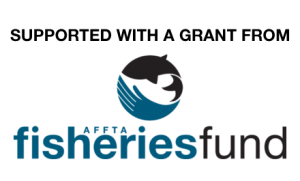ACTION ALERT – Don’t Kick the Can Down the Road
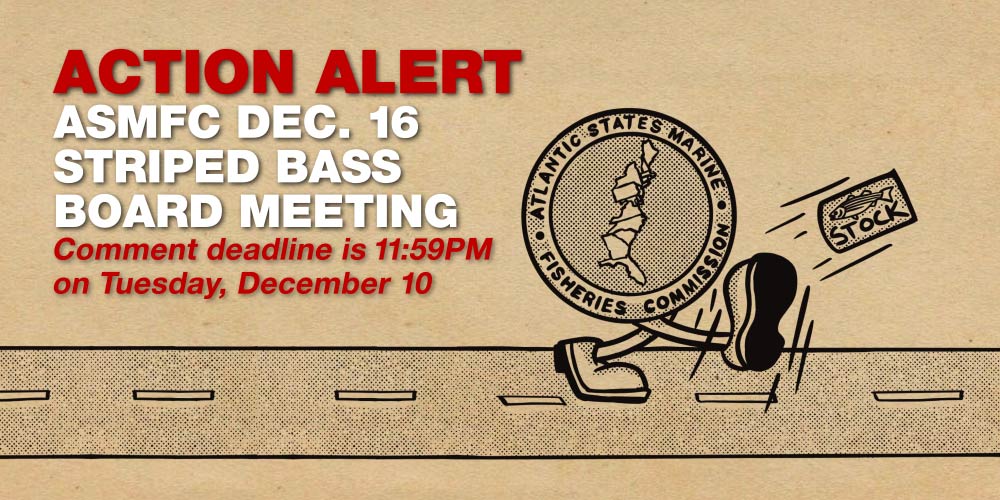
Having endured seven hours of ASMFC striped bass meetings between October and December two things are clear: striped bass are in trouble and the people charged with managing the species are unwilling to admit they have failed to protect them. The options on the table for 2025 are unlikely to succeed and the current ten-year rebuilding plan is already four years behind schedule. And with six straight years of spawning failure in Chesapeake Bay the future looks bleak, but that’s where you come in.
We can’t in good conscience endorse any of the options that will be discussed at the December 16 emergency meeting. Many are inequitable and none are bold enough to reverse a quarter-century of mismanagement. We urge you to continue to speak up in favor of an equitable coast-wide harvest moratorium. We know it made a difference in 2021, and since then some delegates have reluctantly admitted it may be an inevitability. By continuing to speak up in favor of that idea, we can give courage to those who know it is the right thing to do—and the only option left with a chance of succeeding.
The documents provided by the ASMFC (links below) are very complex and do not provide the usual breakdown of options as we would typically see in an amendment or addendum. As you write your comments to the ASMFC here are some key takeaways from the two documents provided by the Striped Bass TC (technical committee) and SAS (stock assessment subcommittee). Your comments should be directed at these points and also clearly state that an equitable coast-wide harvest moratorium is the only proven way to rebuild the stock.
- Move Forward With Caution – The board needs to air on the side of caution when moving forward with management decisions. The overfished status of the stock coupled with failed recruitment (spawning) in Chesapeake Bay means the board needs to make the most conservative reductions. We cannot predict when the current trend of failed recruitment will end, maximized reductions in effort and harvest give the stock the best chance of rebuilding by 2029. How those reductions occur is a bit more complicated.
- No Targeting Closures – For several reasons we cannot support any no targeting closures as they are currently outlined. First off, the law enforcement committee clearly stated, and on multiple occasions, that no targeting closures are unenforceable. If a regulation is unenforceable, then we immediately question any benefit that it might have. Tasking the TC (technical committee) with taking such an in depth look at no targeting closures was a gross mismanagement of valuable resources. In addition, the no targeting closures as they are currently being presented, are inequitable and allow for misuse by states who wish to avoid said closures. As with our call for an equitable coast-wide harvest moratorium, any regulation must be considered for it’s fairness and impact to local economies and stakeholders. As it currently stands, no targeting closures will create more negative impact than they would positively impact the rebuilding of the stock.
- No Harvest Closures – We do support no harvest closures but not how they are currently being considered. As with no targeting closures, equity is the key issue. If seasonal (time based) harvest closures are put into place, they must consider state by state seasons and existing harvest impact on the stock. We truly believe that everyone must make compromises in order to rebuild the stock, but they must be equitable. We cannot allow states to pick and choose, the ASMFC must be in control of those decisions, using sound science as the driving force.
- Adjusting the slot – Stripers Forever has, going back many years, been an advocate for the protection of larger breeding size striped bass. Fecundity (fertility/ egg production) increases in conjunction with the age of a striped bass. Therefore, protecting bigger spawning fish is very important to rebuilding the stock. Especially when we are facing six straight years of poor recruitment in the Chesapeake Bay (the #1 contributor of juvenile striped bass on the Atlantic coast). The board should be considering revising the slot limit, particularly shrinking and dropping the size range down to do everything it can to protect the 2015 and 2018 year classes. Any and all spawning fish need to be protected, they provide our one and only chance at rebuilding the stock.
The deadline for submitting comments is 11:59 p.m. on Tuesday, December 10, so please share your feelings ASAP. Kicking the can down the road is not an option. Insist that the ASMFC move forward with equitable and effective regulations that rebuild the stock. And consider copying your state delegation as well. We’ve come too far to stop now!
Informational Webinar to Review Technical Report
On Thursday, December 5 at 6 p.m. the ASMFC held a informational webinar to review the management options developed by the Technical Committee and provide the public with sufficient background information to inform the development and submission of public comment by December 10. For those who were unable to attend the ASMFC has added that meeting recording to its YouTube Channel. You can find that link below and we strongly encourage everyone to watch it so that you can make informed comments.
MEETING & COMMENT INFO
December 16, 2024 10:00 am – 2:00 pm
Description
The draft agenda and meeting materials for the December 16th Atlantic Striped Bass Management Board Meeting are now available HERE or on the meeting page at https://www.asmfc.org/home/December-2024-AtlStripedBassBoard-meeting.
The Board will meet in-person and via webinar on Monday, December 16 from 10 a.m. to 2 p.m. to consider changing 2025 management measures to increase the probability of rebuilding the stock by the 2029 deadline. The meeting will be held at the Westin Crystal City, 1800 Richmond Hwy, Arlington, VA 22202. The Advisory Panel Report and all written comments received by December 10 will be posted no later than December 13.
The meeting responds to the results of the 2024 Stock Assessment Update, which indicates the resource remains overfished but is not experiencing overfishing. Short-term projections estimate an increase in fishing mortality in 2025 due to the above average 2018 year-class entering the current recreational ocean slot limit combined with the lack of strong year-classes behind it. In this scenario, the probability of rebuilding by 2029 is less than 50%. Under Addendum II to Amendment 7, the Board can change management measures through Board action, instead of developing an addendum, if the stock assessment indicates a less than 50% probability of the stock rebuilding by 2029. As a result, the Board will meet December 16 to consider changing 2025 management measures to reduce fishing mortality and increase the probability of rebuilding to at least 50%.
Webinar Information
The meeting will be broadcast via webinar; to register for the webinar, please go to https://attendee.gotowebinar.com/register/4124340027335222108
(Webinar ID 586-838-579).
If you are joining the webinar but will not be using voice over internet protocol (VoIP), you can may also call in at +1.562.247.8422, access code 389-192-580. A PIN will be provided to you after joining the webinar. For those who will not be joining the webinar but would like to listen in to the audio portion only, press the # key when asked for a PIN.
The webinar will begin 15 minutes prior to the start of the meeting so people can troubleshoot any connectivity or audio issues they may encounter. If you are having issues with the webinar (connecting to or audio related issues), please contact Chris Jacobs at 703.842.0790.
Meeting Process
The Board Chair will ask both in-person and virtual board members if they wish to speak. In-person members can simply raise their hands at the meeting without logging on to the webinar, while virtual members will raise their hands on the webinar. The Chair will work with staff to compile the list of speakers, balancing the flow of questions/comments between in-person and virtual attendees.
The Board Chair will also provide the opportunity for comment at the meeting, taking into account the time allotted on the agenda. The Chair has the discretion in deciding how to allocate comment opportunities. This could include hearing one comment in favor and one in opposition of a motion until the Chair is satisfied further comments will not provide additional insight to the Board.
Public Comment Guidelines
The Commission anticipates a large volume of written public comments will be submitted for this meeting. In order to compile and provide the comments to the Board in a timely manner before the meeting, written comments may be submitted via email to comments@asmfc.org by 11:59 p.m. on Tuesday, December 10. Comments received after this date will not be included in the Board’s materials.
Per the Commission’s public comment guidelines, the Board Chair will provide the opportunity for comment at the meeting, taking into account the time allotted on the agenda. The Chair has the discretion in deciding how to allocate comment opportunities. This could include hearing one comment in favor and one in opposition of a motion until the Chair is satisfied further comments will not provide additional insight to the Board.
ADDITIONAL LINKS – MEETING MATERIALS
- Atlantic Striped Bass Management Board – REVISED Dec. 16 Draft Agenda and Meeting Materials (PDF)
- 2024 Atlantic Striped Bass Stock Assessment Update (Oct 2024) (PDF)
- Atlantic Striped Bass Stock Assessment Update Overview (Nov 2024) (PDF)
ASMFC Informational Webinar to Review Technical Report (Thursday December 5, 2024 6PM EST)
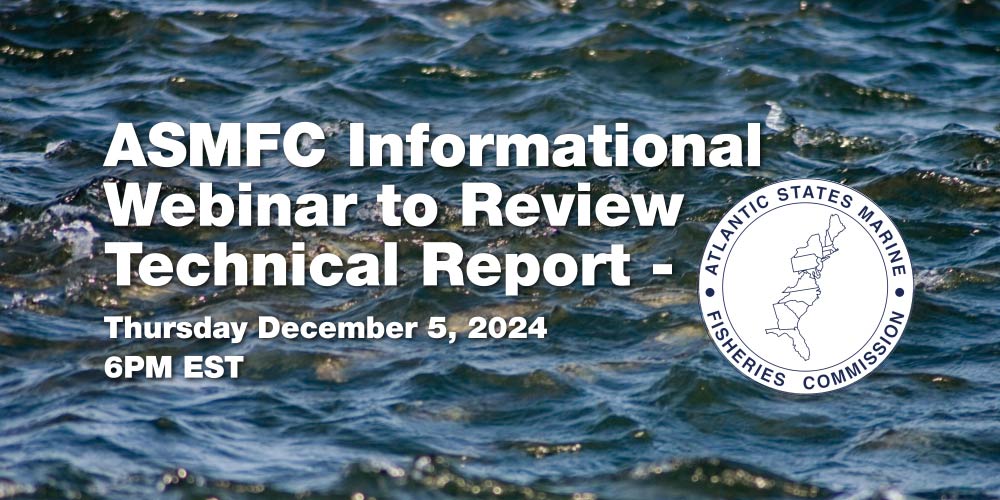
In advance of the ASMFC Striped Bass Board meeting on December 16th and public comment deadline of December 10th (more on that in the near future), the commission will be holding an “Informational Webinar to Review Technical Report“.
From the ASMFC:
The Commission will host an Informational Webinar on Thursday, December 5 at 6 p.m. to review the management options developed by the Technical Committee and provide the public with sufficient background information to inform the development and submission of public comment by December 10. No public comments will be taken at this webinar; staff can address clarifying questions as time allows but public comments will not be taken.
To register for the December 5 Informational Webinar, please go to:
https://attendee.gotowebinar.com/register/3243414609517348697
(Webinar ID 263-766-419)
If you are joining the webinar but will not be using voice over internet protocol, you can may also call in at +1 (562) 247-8422, access code 195-793-780. A PIN will be provided to you after joining the webinar. For those who will not be joining the webinar but would like to listen in to the audio portion only, press the # key when asked for a PIN.
For more information, please contact Emilie Franke at efranke@asmfc.org.
ADDITIONAL LINKS – MEETING MATERIALS
- 2024 Stock Assessment Update (PDF)
- Atlantic Striped Bass Management Board – REVISED Dec. 16 Draft Agenda and Meeting Materials (PDF)
ASMFC 2024 Annual Meeting Summary & Action Alert Winners
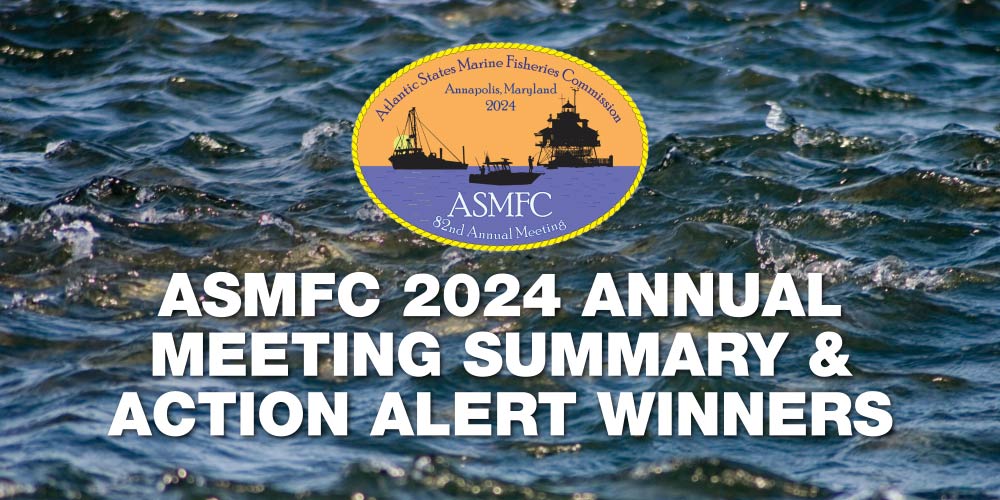
Last Wednesday, October 23, 2024 the Striped Bass Management Board met durning the ASMFC 2024 Annual Meeting. It was a six-hour meeting and we came away with mixed feelings.
There are clearly some board members who refuse to admit (publicly) that wild Atlantic striped bass are on the brink of another collapse. Rather than accept their own data and look for solutions, they instead choose to side with constituents who demand the right to not only keep killing fish, but to kill more of them. Representatives of the commercial fishing community and for-hire fleets argued that their demands should take priority over tens of thousands of recreational anglers and the businesses that serve them.
But there were also some board members who, recognizing that the situation facing striped bass is a crisis, expressed frustration with their colleagues who stand in the way of meaningful action. That gives us hope that there will be action in the future. The only question is, will that action happen in time?
Here are some quick takeaways from the meeting:
- The 2024 Stock Assessment update suggests that the stock will not rebuild by the 2029 deadline without the intervention of the board and a further reduction in fishing mortality.
- The stock is currently overfished but not experiencing overfishing in 2024.
- There is some uncertainty around the current assessment due to incomplete MRIP data.
- Research suggests that the mandated use of circle hooks has not improved release mortality as believed.
- The Massachusetts Division of Marine Fisheries/University of Massachusetts study affirmed a 9% overall rate of recreational release mortality, although there needs to be a closer look at regional influence.
- The spawning stock biomass showed a slight improvement as fish from the 2017 year-class reached sexual maturity, but the biomass is also being hit hard by both commercial and recreational harvest. Commissioners expressed concern that the lack of spawning success means that biomass will quickly decline without a significant reduction in harvest.
- A lot is riding on the 2018 year-class as most of those fish have now likely grown to where they have reached the coastal recreational slot and commercial size limit.
It’s easy to see that these findings add up to bad news for the fish that remain in the ocean and on which the future depends. And while policy change was not on the October agenda, a motion passed to hold an emergency meeting in December to debate and, hopefully, take action for 2025 aimed at effecting a meaningful reduction in harvest.
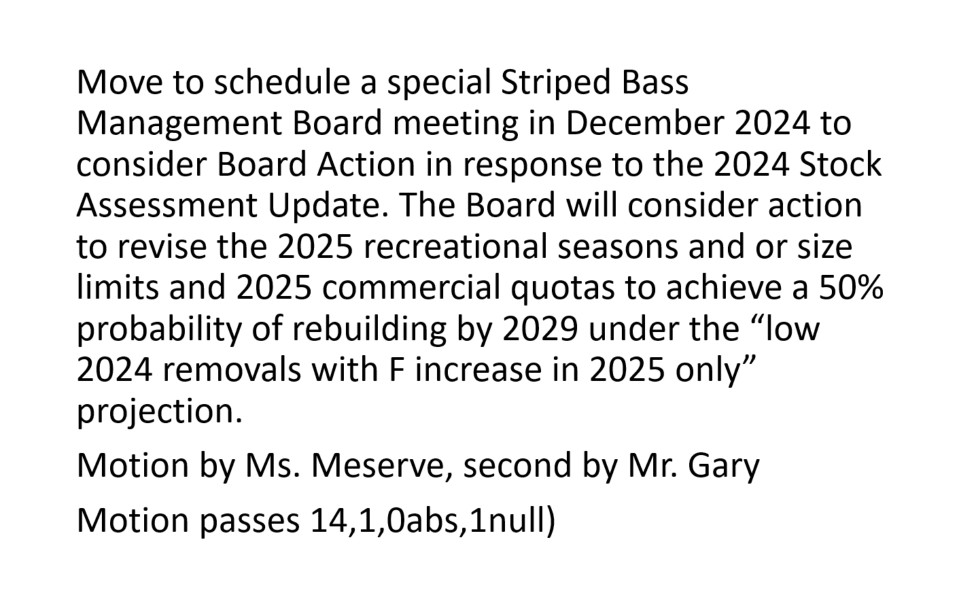
Unfortunately, the Maryland and Delaware delegations made the dubious contention that it is already too late for them to change regulations for their commercial fisheries. Such arguments were, in our opinion, pre-emptive and intended as damage control to show their friends that they are fighting for their interests. We’ll see how it plays out since any cuts to harvest should be equitable across all user groups.
It is worth noting that the idea of a moratorium, which we have pushed for since 2021 and the debate over Amendment 7, did show up in subtle ways. Whereas in 2021 the reactions to our proposal were hostile (to put it mildly), there were signals that, if things do not improve measurably by this time next year, such an idea might be reasonable.
What does that mean for Stripers Forever?
Thanks to the steadfast pressure that our members have put on the ASMFC through public comments, we have clearly changed the conversation to the point where some delegates have left the door ajar. Comments received by the ASMFC prior to this meeting were overwhelmingly supportive of an equitable harvest moratorium, and we believe that some influential voices in the fishing community are coming to grips with the idea that a moratorium is likely the only arrow left in the ASMFC’s management quiver that has a chance of hitting the target.
So where do we go from here?
There will likely be a call for public comments prior to the December meeting and we will let you know at that time what we think the best response will be. Please keep your eyes open for those messages. The TC (technical committee) will also be working on some assignments from the board. The information gained from the below will help guide the board in deciding the best action plan to ensure a rebuilding of the stock by 2029. Unfortunately, the board seems satisfied with a 50% or at best 60% chance of rebuilding by 2029. So, the fate of stock and the economy which it supports is decided by a coin toss. Not the way we would do business and in our humble opinion, a losing bet.
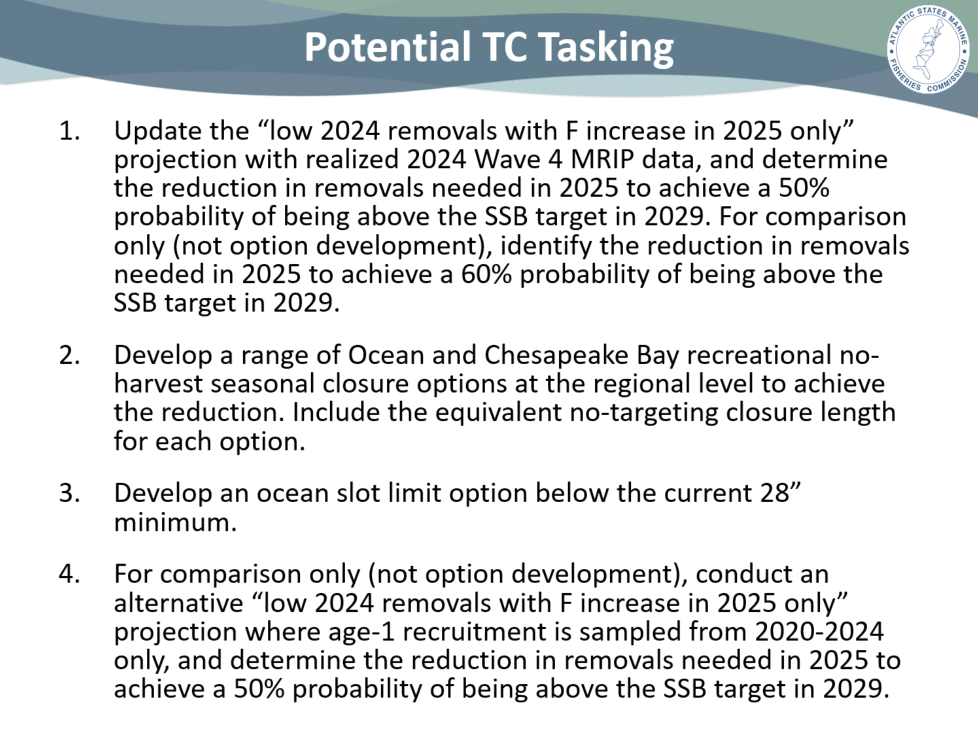
In the meantime, thank you for your support and for your concern for the future of wild Atlantic striped bass.
This is the statement we read at the outset of the meeting:
Recreational slot and commercial size limits focused on harvesting breeding-sized fish.
Gill nets in the Bay—legal and illegal—killing fish indiscriminately.
Environmental conditions squeezing the spawning window so narrow that there is no room for error.
Mycobacteriosis. Predation. Invasive species. Warming water. Lack of forage.
It adds up to a crisis for striped bass. And yet, as with every other meeting of the striped bass technical committee, there will be lots of numbers and charts and formulas cited as sleight of hand to convince the public that the fisheries managers have things under control and that we just aren’t smart enough understand. And yet we’ve had a quarter-century of the smartest people in the room presiding over a steady decline in the striped bass population.
In 2021 I was among the voices calling for the ASMFC to do something bold and initiate a ten-year recreational and commercial harvest moratorium. I, and many others, asked that the fishery be shut down long enough to give striped bass a chance to recover and achieve the abundance and healthy age stratification the Commission claims are its management goals.
And now, after six straight years of spawning failure, this meeting will likely conclude with more of the same: incremental tweaks to a ten-year recovery plan that is entering its fourth year with no indication that improvement is imminent, and the remaining breeding population producing numbers insufficient to fill the reproductive pipeline.
What will it take for the ASMFC to find the courage to do the right thing and shut the fishery down for the sake of the future of striped bass? Pausing the commercial harvest and imposing a zero-bag limit for recreational anglers is the last, best hope for recovery.
If the Commission is serious about achieving its goals, an equitable harvest moratorium needs to be a part of the debate.
ACTION ALERT – WINNERS

A BIG THANK YOU to those who took the time to be part of the process!
Winners of the 5 limited edition SFxSLP striped bass bracelets have been notified via email. Once shipping addresses have been confirmed bracelets will be shipped.
ADDITIONAL LINKS
- ASMFC 2024 Annual Meeting: News Release 10/24/24 – Atlantic Striped Bass Stock Assessment Update Finds Resource Remains Overfished With A Less Than 50% Chance of Rebuilding by 2029 (PDF)
- ASMFC 2024 Annual Meeting: Presentations (PDF)
- ASMFC 2024 Annual Meeting: Audio/Video Meeting Recording (YouTube)
Six Straight Years of Failed Striped Bass Spawning
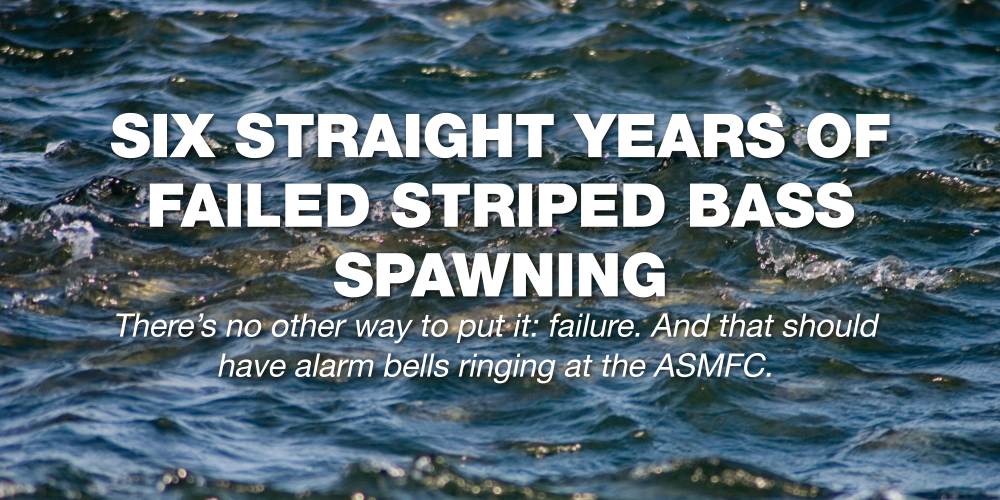
Maryland and Virginia reported their 2024 juvenile young of year indexes for striped bass. There’s no other way to put it: failure. That’s six straight years of dismal reproduction in the most important nursery for wild Atlantic striped bass. And that should have alarm bells ringing at the ASMFC.
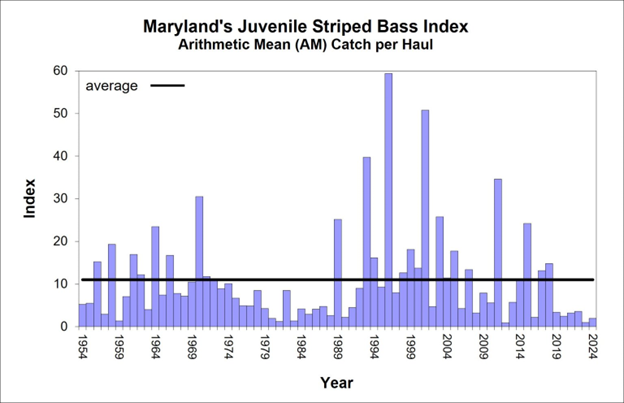
Female striped bass reach sexual maturity between four and eight years. That means the 2017 and 2018 year classes—the last two that were above average—are not showing up to reproduce as hoped. The ASMFC already admitted that the good 2015 year class is a lost cause, and so there are very few breeders left available to return in the spring. Yet the harvest continues to be focused on breeder-sized fish.
Right now, Maryland’s Juvenile Striped Bass Index looks a lot like it did in the mid-1970s when the striper population collapsed. The action that changed the fish’s fortune then was a harvest moratorium, and even though not every state chose to do so, it was the moratorium that brought the fish back from the brink. Let the ASMFC know that they can’t wait fifteen years. Now is the time to do the right thing and enact a coastwide equitable (recreational and commercial) harvest moratorium.
ADDITIONAL LINKS
- MD Department of Natural Resources: Results of Chesapeake Bay 2024 Young-of-Year Striped Bass Survey Show Little Change
- Virginia Institute of Marine Science: A poor year for juvenile striped bass in Virginia waters in 2024

